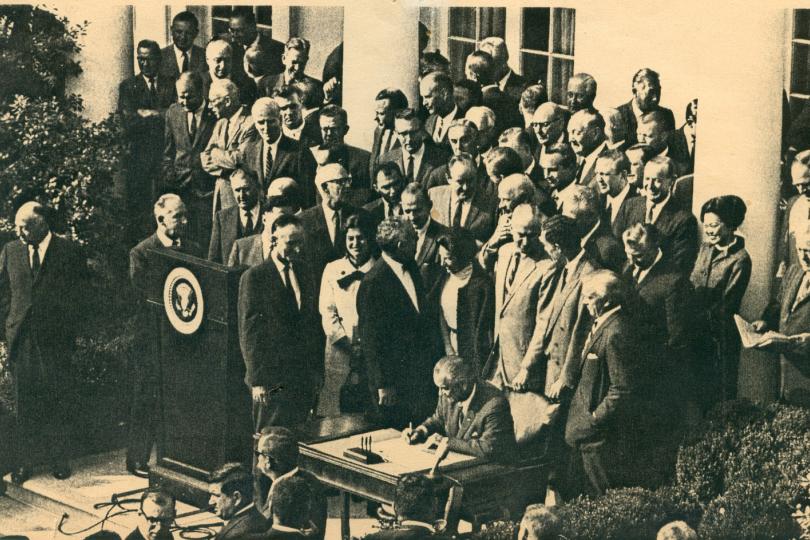The chopping block

In less horrifying local news
Hey, friends. My blood is boiling after writing this week's edition of News and Notes. I think you know why. If you don't, then read on.
In the meantime, enjoy these local theater stories that are a bit happier than the national picture at the moment.
(1) Tom Hoch decided to step down from his leadership post at Hennepin Theater Trust even earlier than originally planned; but don't worry: there's already a new interim in place.
(2) Remember when Gremlin Theatre closed up their space? They're getting ready to make a triumphant comeback to St. Paul!
(3) TCG just announced the latest recipients of the Fox Foundation Resident Actor Fellowships, and two of the six winners are Twin Cities performers. Congratulations to Taous Khazem and Luverne Seifert! Take good care of that sweet foundation cash!
The first cut is the deepest
Oh, good lord, it really happened. I was hoping that this was all some hyper-real fever dream that I had after downing a half-and-half mixture of NyQuil and DayQuil the last time I had the flu; but, sadly, no, this is our reality: Donald Trump is now our president, and he has a special plan for your life. That special plan is to send angry tweets out every morning at 3AM and sign whatever pieces of paper Mitch McConnell and Paul Ryan push in front of his face every afternoon. Then he'll eat a Big Mac while combing his hair over in the mirror and telling his reflection "You're a star. You're a big, bright beautiful star." Then he'll pass out while muttering, "It needs more gold paint…" until his next 3AM twitter session. Welcome to the next four years of your government.
(Also, you should know that "half-and-half mixture of NyQuil and DayQuil" is the new Republican health care plan. You can start panicking now.)
So, what do you do? Well, you've done protesting; you've done marching; you've done angry, drunken rants on Facebook at four in the morning; but it's still happening. You can't argue with reality; though, apparently, you can have a press secretary do it for you.
What are we going to do, artists? What are we going to do? Artists of all stripes are trying to figure out what to do now. It might feel good, but you're not going to sing your way out of this one.
According to a recent report from The Hill, while you were sharing your latest funny, ironic meme about our new führer, Trump's team of demolition experts was preparing the charges and setting the timers. On the list of budgetary cuts in the new year are a few organizations I would guess most of my readers are none too thrilled about, including the National Endowment for the Arts, the National Endowment for the Humanities and the Corporation for Public Broadcasting. You might recognize these as the three major federal supporters of arts and culture in the US.
This is far from the first time Republicans have threatened to mow down the arts. These funding sources have been in conservative crosshairs almost since their inception; and it's definitely not because of any money they might save. The list of cuts that Trump's minions have reportedly outlined does not add up to the savings that they are claiming. Anyone with patience and a calculator can see that. The three cultural agencies in question account for 0.02% of the federal budget. That's like dropping a single penny in your piggy bank and claiming that you've solved all your financial woes for the rest of your life.
Let's be honest: this isn't about saving money. Conservatives love to talk all day long about shrinking the size of the government and saving taxpayers money; but, in my lifetime, there has never been a Republican administration that has reduced the size of the government. The reason "Cut the NEA!" is such a popular conservative trope is because it's a lazy way to pretend that you're serious about cutting the budget, and it's symbolic of the deeper implications of modern conservative policies: that there is no such thing as a "common good" anymore. (It also has the added benefit of symbolically sticking it to those artsy liberals that opposed them; it's exactly the kind of petty payback that a small-minded guy like Trump gets off on.)
You artists out there are going to have to find ways to adapt and survive these next four years, or you're going to find yourself penning a goodbye letter to the profession that you love. Even though the NEA is really a pittance compared to the federal budget, it does filter down a lot of opportunities and multiplier effects into the the national arts scene. For the future, please know that "selling out" is a perfectly respectable strategy. (It's actually what fueled the arts through most of history from the Renaissance up into present day, so don't poo-poo it so quickly.)
This also means that private foundations and nonprofits looking for their money are going to have to find better ways to talk to each other. The great blog Nonprofits With Balls recently came out with two very important reality checks that both groups should be referencing: (1) a quiz for foundations to see how aggravating their grant application process is; and (2) a quiz for nonprofits to see how irritating their practices are for funders.
Other options
If Trump and company are actually serious about cutting "wasteful" spending from the federal budget, I would like to offer up some suggestions that don't eat away at the soul of America like battery acid on exposed skin. Instead, here are a list of ideas that would get rid of actual waste and bloat in the budget.
(And, yes, I did do the math on how much extra security for Trump Tower will cost, since our new President doesn't seem to understand that we have this whole mansion in Washington D.C. for him already; but I want to talk about things that have a snowball's chance in hell of being cut, and we all know that Trump will give up his golden penthouse when you can pry it from his cold, dead, tiny hands. That's $182 million per year, by the way.)
So, here's a modest list of things that will help cut the federal budget without actually hurting anything:
(1) Get rid of pennies
Because of the natural course of inflation, a penny has become essentially worthless. When the greatest use of a penny in your life is to feed it into one of those machines at the zoo that flattens it out and stamps a panda on it, it's time to admit that this is worthless money. Our federal mints pop out 9.6 billion copper-coated zinc pellets per year at a cost of 1.5 cents per coin. It's time for this charade to end. Canada eliminated their penny in 2013, immediately saving themselves $11 million a year without any measurable detriment to their economy, and they didn't produce nearly the number of pennies that we have.
Cost savings: $137 million per year
(2) Get rid of $100 bills
While we're axing needless currency, why not go to the top, too? $100 bills account for 80% of the US paper bills in circulation, but you hardly ever see them in the wild. Why? The major use of $100 bills is for illegal activities, including smuggling, money laundering and black market sales. It's also the primary way that currency leaves the US and winds up hoarded in foreign countries, usually for unsavory purposes. Yet, the US mint pumps out 3 billion new $100 bills each year at 14.3 cents per bill. Granted, the government makes some money by printing new bills through the arcane process of seigniorage, but that rate of return drops the more that they print, and the reduction in financial losses to crime that would result from losing the $100 bill would easily offset that.
Cost savings: $429 million per year
(3) Stop manufacturing Abrams tanks
Every year, the military tells Congress that they don't need anymore friggin' M1 Abrams tanks, and every year like clockwork, Congress forces them to buy more, even though we already have 2,000 unused tanks sitting at an army depot in California. By the way, we haven't fought a tank battle since the first Gulf War. (FYI: That was three presidents ago.)
Cost savings: $558 million per year
(4) Stop buying surplus military gear for local police departments
For a number of incredibly stupid reasons having nothing to do with actual requests or need, the US military was basically ordered to overpurchase billions of dollars worth of equipment during our most recent escapades abroad. What to do with it? Give it away to police departments who are in no way trained or qualified to operate military-grade hardware. This is how your local police department may have wound up with an unnecessary stash of assault weapons, armored vehicles and bayonets. (Yes, I said freaking bayonets for the police. Isn't that comforting?) Apparently, it never occurred to Congress that the military could just not buy all this excess gear in the first place. As an added bonus, your local police department won't cause $40,000 in damages when they're out joyriding in their new MRAP.
Cost savings: $2.2 billion per year
(5) Get rid of land-based ICBMs
This one's going to be tough, because the Defense Department has never really left the Cold War; but if anyone can bully this one through, I'm sure the Donald can. We spend a lot of money maintaining a series of Minuteman III missiles tipped with nuclear warheads in hidden underground bunkers across the middle of America. In reality, they are a remnant of our old Cold War strategy, meant to offer up enticing targets far away from our population centers for Soviet missiles so that the other legs of our nuclear triad could do actual damage. It's a lot of money to spend for what basically amount to decoys, and our submarine and bomber-based nuclear arsenal is much more accurate, flexible and deadly. Now, I know that Trump said, "let it be an arms race" about nukes, but based on the rest of his comments, it's pretty clear that he doesn't understand what a nuclear triad is. As long as we don't explain it to him, I'm pretty sure we could convince him to build big empty silos in North Dakota that just look like missile sites (as long as they're painted gold and have "TRUMP" written on them).
Cost savings: $2.6 billion per year
(6) Stop the F-35 joint strike fighter program
OK, folks, if you don't know about this one, it's going to blow your pretty little minds right out the back of your heads, and not just because it comes equipped with gatling guns. In the early 2000s, the US military contracted with Lockheed Martin to begin development of the F-35 Joint Strike Fighter, codenamed "Lightning" (you will find that name depressingly ironic in just a few sentences.) It was intended to replace three different jets that did three different jobs (the F-16 fighter jet, the F/A-18 carrier jet, and the A-10 attack plane) and it does all three jobs equally poorly. Even though Lockheed Martin has already delivered the first generation version of the F-35, every variant of the plane is riddled with problems, including, but not limited to: a fuel tank with serious flaws that increase the risk of explosion; software that was found to be easily hackable (and which may have already been swiped by the Chinese government); a fancy new pilot's head's up display (HUD) that was disorienting, confusing and occasionally gave wrong information; an emergency ejection system that may straight-up murder a pilot if they weigh too little; and a body design that offers almost no protection from lightning strikes (remember what I said earlier about irony?)
Because of all this, the F-35, though technically in active deployment, is not able to fly during thunderstorms, dust or rain, is not recommended for use at night, and is not able to deploy heavy munitions for bombing. The fact that it was considered a major breakthrough when the damn thing could operate for longer than 15 hours without its software freezing up and restarting should give everyone serious pause. If Apple advertised their latest iPhone by saying, "It can run for a little over half a day before it locks up and you have to reboot!" it would be piling up in return warehouses, and that's a product that absolutely no nation's security depends on.
And, we're getting all this for the low, low price of only sweet tap-dancing Christ, it's $1.45 trillion goddamn dollars?! Lockheed Martin delivered the first round of this boondoggle at $207 million per plane. The math-inclined among you might recognize this as substantially more than the annual NEA budget, for one mother-loving plane that can't even be used in real combat situations. Sure, Lockheed promises that these costs will be lower in the future, but since the F-35 program has basically been in cost overruns since its inception, you should take those numbers with a grain of salt the size of the goddamn moon.
Cost savings: For god's sake, people, this is enough to give every man, woman and child in America $4,500!
Seriously, you guys, even forgetting about the NEA for a second, do you have any idea what we as a nation could do with the $1.45 trillion that will be wasted on this program? According to that article that I just linked to, we could hire Beyonce to do a show a night for 1,000 years straight, and that's not even the coolest thing on the list!
Even Donald Trump blasted this program, though odds are pretty good that he doesn't remember saying that. Let's be honest: he barely remembers breakfast. You know what? Let's remind him.
Here's two petitions that I recommend: one that demands no cuts to the NEA and NEH, and one that demands the F-35 program be cut.
And, never forget that you can totally badger the hell out of your elected representatives. That's what living in a democratic republic is all about. And, if you need help translating this to conservatives who refuse to hear anything that doesn't have positive dollar signs attached to it, just wait until next month when the latest Creative Minnesota report comes out. This will give you all sorts of facts and figures to show that, actually, investment in the arts pays off in both spiritual and monetary ways.




